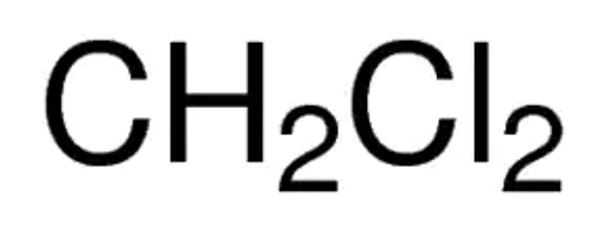Description
DCM (methylene chloride), 40-150 ppm amylene as stabilizer, ACS reagent, 99.5%, 16LL
Synonym(s):
Methylene chloride, methylene chloride
Empirical Formula (Hill Notation):
CH2Cl2
CAS Number:
75-09-2
Molecular Weight:
84.93
Beilstein:
1730800
EC Number:
200-838-9
MDL number:
MFCD00000881
PubChem Substance ID:
329798828
NACRES:
NA.04
PROPERTIES
Quality Level
200
grade
ACS reagent
vapor density
2.9 (vs air)
vapor pressure
24.45 psi ( 55 °C)
6.83 psi ( 20 °C)
assay
≥99.5%
form
liquid
autoignition temp.
1223 °F
contains
40-150 ppm amylene as stabilizer
expl. lim.
22 %
impurities
Free halogens, passes test
≤0.0003 meq/g Titr. acid
≤0.02% water
evapn. residue
≤0.002%
color
APHA: ≤10
clear
refractive index
n20/D 1.424 (lit.)
bp
39.8-40 °C (lit.)
mp
−97 °C (lit.)
density
1.325 g/mL at 25 °C (lit.)
SMILES string
ClCCl
InChI
1S/CH2Cl2/c2-1-3/h1H2
InChI key
YMWUJEATGCHHMB-UHFFFAOYSA-N
General description
Dichloromethane (DCM) is a chlorinated organic solvent with a wide range of industrial applications and organic syntheses. It has a low boiling point, high density and is immiscible in water. DCM is susceptible to degradation with time, which can be suppressed by adding amylene as a stabilizer.
Application
Dichloromethane
b) Enyne metathesis, widely used catalyst is the Grubbs′s second-generation ruthenium complex
c) Jacobsen-Katsuki epoxidation
d) Boc-deprotection of immobilized Boc-NH2-poly(ethylene glycol)-plasma layers
e) Can react with phosphines or amines in the formation of the corresponding alkylated products
- Organic synthesis
b) Enyne metathesis, widely used catalyst is the Grubbs′s second-generation ruthenium complex
c) Jacobsen-Katsuki epoxidation
d) Boc-deprotection of immobilized Boc-NH2-poly(ethylene glycol)-plasma layers
e) Can react with phosphines or amines in the formation of the corresponding alkylated products
- Adhesive and paint formulation
- Extraction-concentration analysis
- Flash chromatograph
- Electronic industry in printed circuits board
- Production of cellulose triacetate
Packaging
200 L in Pure-Pac™ 2
500 mL in glass bottle
18, 20 L in steel drum
1, 6×1, 2.5, 4, 4×4 L in glass bottle
200 L in steel drum
Features and Benefits
ACS solvents meet or exceed the high standards of the American Chemical Society (ACS), with test specifications that are specialized to every compound. According to the American Chemical Society, ACS reagent grade implies that it is a substance of sufficient purity to be used in most chemical analyses or reactions
SAFETY INFORMATION
Signal Word
Warning
Hazard Statements
H315 - H319 - H336 - H351
Precautionary Statements
P201 - P202 - P261 - P302 + P352 - P305 + P351 + P338 - P308 + P313
Hazard Classifications
Carc. 2 - Eye Irrit. 2 - Skin Irrit. 2 - STOT SE 3
Target Organs
Central nervous system
Storage Class Code
6.1D - Non-combustible, acute toxic Cat.3 / toxic hazardous materials or hazardous materials causing chronic effects
WGK
WGK 2
Flash Point(F)
does not flash
Flash Point(C)
does not flash





